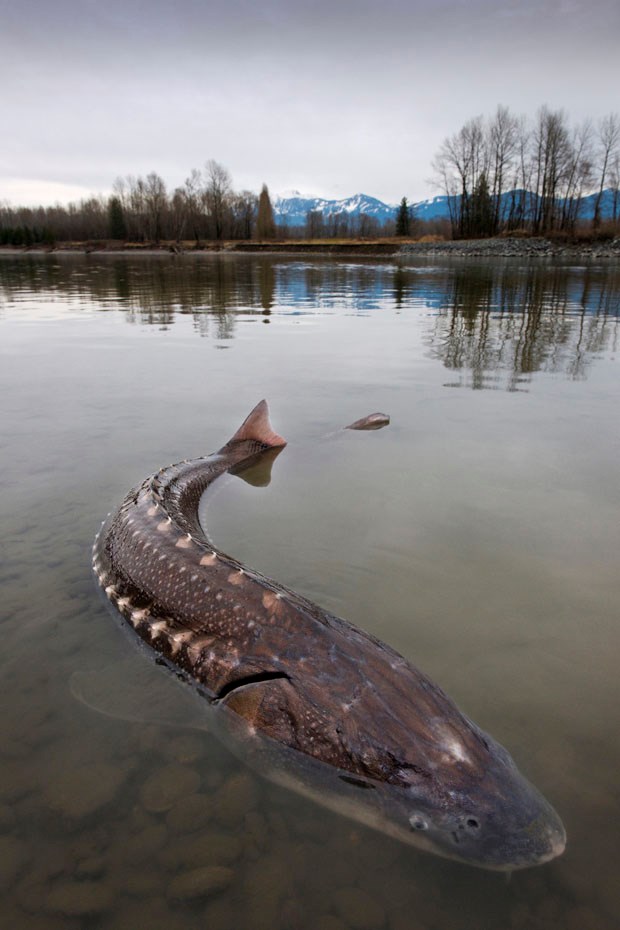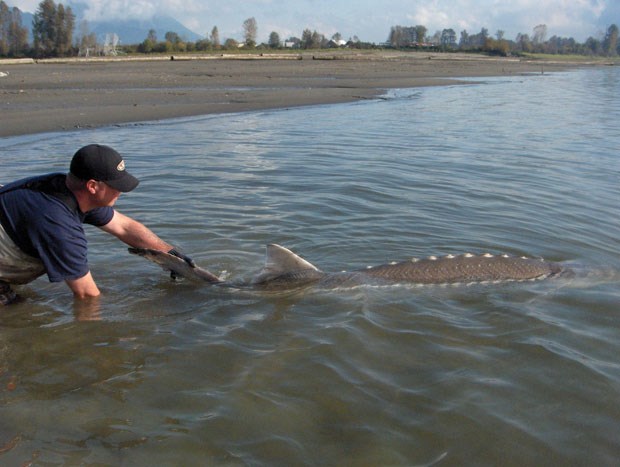Delta shares a special part of the Fraser River and sturgeon history.
At the turn of the previous century this area was home to one of the largest sturgeon fishery export industries - with more than 7.5 million pounds of sturgeon meat and caviar being sent to overseas markets between 1892 and 1902. At that time the sturgeon export industry was considered one of the key building blocks of the provincial economy.
Fast forward to today however, the future for the Fraser's prehistoric giant is in jeopardy.
White sturgeon is a threatened species due to Gill-net by catch mortality of other in-river fisheries, habitat loss, low numbers of juveniles and poaching.
But thanks to the volunteer efforts of the Fraser River Sturgeon Conservation Society (FRSCS), they hope to reverse this trend.
"We are privileged to have a world-class fishery here in B.C. and a significant portion of sturgeon enthusiasts enjoy sturgeon encounters right here on the Fraser River in the
Delta area," said John Rissling, a 16-year volunteer and board member. "I have lived in Ladner since the early 70s and most people I have talked with think sturgeon are just the 'caviar' fish - that's all they know about it. Most of these people out boating in Ladner have no idea that these dinosaurs are beneath them. They need our help and that is what this organization is all about."
In the early 1990's, sturgeon suffered a major die-off where dozens of mature sturgeon washed up dead along the shores of the Fraser River. No one knew why or how these prehistoric fish perished. So in 1997, long-time conservationist, and Canada's Man In Motion, Rick Hansen brought together a group of leaders to form the FRSCS with a mandate to restore and protect this wild population of sturgeon.
"We achieve this through research, education, outreach and advocacy," said executive director Sarah Schreier. "Leaders from sectors that all shared an interest in seeing the long-term sustainability of this species including First Nations, commercial and recreational fishers, community leaders, biologists and business leaders make up this group. To this day, representatives from all these sectors remain active board members, sharing their expertise, passion and energy to make a difference."
Today, sturgeon fishing is 'catch and release' only and communities all along the Fraser River continue to benefit from the millions of dollars per year this fishery draws into the economy.
"Thanks to the ongoing catch-and-release fishery and contribution from many volunteer and professional anglers, we have established the only program monitoring the health of Fraser River white sturgeon," Schreier added. "Our research is used by decision-makers to ensure that resource management policies and regulations for this fishery are made with the best information available. It is also used when proposals for developments, industry and other in-river activities are being designed and put forward."
But for Schreier and Rissling, the work of the society has really only just begun.
"This is a threatened species. The populations are nowhere what they use to be," she said. "We essentially clear cut the stocks at the turn of the century. This fish does live to be 200 years old, it grows to 20 feet, it only reaches sexual maturity between 20 and 26 years for females and 12 years for males and then they only spawn every six to 11 years in the wild, so we are talking about a potentially huge gap even way back from when those big fish were hauled out. If we look at how many fish were taken at that time to now where we are estimating just over 47,000 fish in our study span, there are not the numbers that there use to be. They need our help to ensure their long-term sustainability."
Rissling said there is a real passion about the fishery once you get involved with it.
"My daughter asked me an interesting question when we were out fishing a couple of weeks ago. She asked me if they ever got to a point with the fishery where you could retain the fish, would you do it? I said I couldn't do it. The sturgeon are my friends now. After 16 years I could never retain one and eat it. So there is a real passion amongst sturgeon fishermen and we feel connected to the fish through what we are doing with the society because we are making a difference."

Schreier said abundance levels of the population have been holding pretty steady over recent years, and they have hope that with ongoing research and awareness the population will grow.
"Because this is a longlive fish, we have incredible information on them, but there is so much more we need to know," she added. "They are an extraordinary species. We need to continue to do research and build on what we know so we can champion protection and preservation."
To learn more about the FRSCS, a non-profit society, check out: www.frasersturgeon.com. On the website you will find information about the society, how to volunteer and get involved, information and videos about the proper handling of fish.
For local anglers looking for more information, they can call Rissling at 604-290-7492 or email: [email protected].



